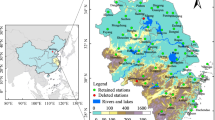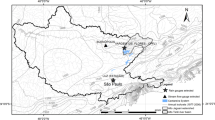Abstract
Based on the summer precipitation data from the Huaihe River valley and the middle and lower reaches of the Yangtze River from 1922 to 2007, we analyzed the interannual and interdecadal oscillation and probability distribution characteristics of summer precipitation in the Huaihe River valley during the same period, using the wavelet transform and generalized extreme distribution methods. Whereby, we studied the climate background of East Asia Summer Monsoon (EASM), Sea Surface Temperature (SST), East Asia telecorrelation circulation, and their relationship with the interannual and interdecadal oscillation of summer precipitation in the Huaihe River valley. We further compared the difference of interdecadal oscillation of summer precipitation and the relevant climate background between the Huaihe River valley and the middle and lower reaches of the Yangtze River. The results show that: 1) The intensity change of quasi-biennial oscillation (QBO) of summer precipitation in the Huaihe River valley is consistent with that of interdecadal oscillation. The summer precipitation in the Huaihe River valley has been more than normal since the end of the 1990s, and the QBO is very significant. Meanwhile, the probability of occurrence of extreme heavy rainfall increased obviously. 2) The interdecadal oscillation of summer precipitation in the Huaihe River valley has a close relationship with the Pacific Decadal Oscillation (PDO) and interdecadal oscillation of EASM. When PDO is in the cold phase and EASM weakens, the summer precipitation will be greater than normal. 3) QBO of summer precipitation in the Huaihe River valley is mainly controlled by that of EASM, and it has a relationship with a circulation pattern of “positive-negative-positive” from the high to the low latitudes in East Asia. 4) There is interdecadal phase difference in summer precipitation between the Huaihe River valley and the middle and the lower reaches of the Yangtze River, which is mainly related to the intensity and position of West Pacific subtropical high.
Similar content being viewed by others
References
Jin Z D, Tao S Y. A study on the relationships between ENSO cycle and rainfalls during summer and winter in eastern China (in Chinese). Chin J Atmos Sci, 1999, 23: 664–672
Zhang R H, Sumi A, Kimoto M. A diagnostic study of the impact of El Niño on precipitation in China. Adv Atmos Sci, 1999, 16(2): 229–241
Huang R H, Zhang R H, Zhang Q Y. The 1997/98 ENSO cycle and its impact on summer climate anomalies in East Asia. Adv Atmos Sci, 2000, 17: 348–362
Xu Y H, Tao S Y. Interannual Change of Summer Monsoon in East Asia and Droughts and Floods in Bai-urainy Period in Jianghuai Area, Progress and Diagnosing of Disastrous Climate (in Chinese). Beijing: China Meteorological Press, 1996, 31–39
Ding Y H, Sun Y. Study on anomalous activities of East Asian summer monsoon. J Meteorl Soc Jpn, 2001, 79: 1119–1137
Zhang Q Y, Tao S Y. The anomalous subtropical anticyclone in Western Pacific and their association with circulation over East Asia during summer (in Chinese). Chin J Atmos Sci, 2003, 27: 369–380
Ju J H, Sun D, Lv J M. The influence of the East Asian monsoon stream on the large-scale precipitation course in eastern China (in Chinese). Chin J Atmos Sci, 2007, 31: 1129–1139
Zhao Z G. Summer Droughts and Floods and the Relative Circulations in China (in Chinese). Beijing: China Meteorological Press, 1999. 86–94
Huang R H, Cai R S, Chen J L, et al. Interdecaldal variations of drought and flooding disasters in China and their association with the East Asian climate System (in Chinese). Chin J Atmos Sci, 2006, 30: 730–743
Chen X F, Song W L. Analysis of relationship between snow cover on Eurasia and Tibet Plateau in winter and summer rainfall in China and application to prediction (in Chinese). Plateau Meteorol, 2000, 19: 215–223
Deser C, Phillips A S, Hurrell J W. Pacific interdecadal climate variability: linkages between the tropics and the North Pacific during boreal winter since 1900. J Clim, 2005, 17: 3109–3124
Wu B Y, Zhang R H. Decadal change of abnormal SST in summer in Southwest Pacific in late 1980s. Chin Sci Bull, 2007, 52: 1190–1194
Wei F Y. An integrative estimation model of summer rainfall-band pattern in China. Prog Nat Sci, 2007, 17: 280–288
Mantua N J, S R Hare, Zhang J M. et al. A Pacific interdecadal climate oscillation with impacts on salmon production. Bull Amer Meteorol Soc, 1997, 78: 1069–1079
Minobe S, N J Mantua. Interdecadal modulation of interannual atmospheric and ocean variability over the North Pacific. Prog Ocean, 1999, 43: 163–192
Wei F Y. Modern Statistic Diagnosing and Protesting Skill of Climate, 2nd ed. (in Chinese). Beijing: China Meteorological Press, 2007. 63–66
Gu W, Li C Y, Yang H. Analysis on interdecadal variation of summer rainfall and its trend in east China (in Chinese). Acta Meteorol Sci, 2005, 63: 728–739
Liu T Z, Rong P P, Liu S D, et al. Wavelet analysis of climate jump. Chin J Geophys, 1995, 38: 158–162
Ding Y G. Exploring theory basis of disaster laws—probability of extreme climate events (in Chinese). Study Meteorol Disasters, 2000, 29: 44–50
Ding Y H, Chen L X, Murakami M. Asia Monsoon. Beijing: Meteo rol Press, 1994. 1–293
Chen L X, Zhang B, Zhang Y. Progress in research on the East Asian monsoon (in Chinese). J Appl Meteorol Sci, 2006, 17: 711–723
Miao J H, Lao K M. Interannual variability of East Asian mondoon rainfall. Q J Appl Meteorol, 1990, I: 377–382
Tian S F, Yasunari T. Time and space structure of interannual variations in summer rainfall over China. J Meteorol Soc Jpn, 1992, 70: 585–596
Chang C P, Zhang Y S, Li T. Interannual and interdecadal variations of the East Asian summer monsoon and tropical pacific SSTs. Part I. J Clim, 2000, 13: 4310–4340
Guo Q Y, Cai J N, Shao X M, et al. Studies on the variations of East-Asian summer monsoon during A D 1873–2000 (in Chinese). Chin J Atmos Sci, 2004, 28: 206–216
Nitta Ts. Convective activities in the tropical western Pacific and their impact on the Northern Hemisphere circulation. J Meteorol Soc Jpn, 1987, 64: 373–390
Huang R H, Chen W, Yan B L, et al. Recent advances in studies of the interaction between the East Asian winter and summer monsoons and ENSO cycle. Adv Atmos Sci, 2004, 21: 407–424
Fu C B, Teng X L. Relationship of abnormal summer climate in China with El Niño/SO (in Chinese). Chin J Atmos Sci, 1988, 12(Suppl): 133–141
Mo R P. Relationship of interannual oscillation of precipitation and temperature in China with El Niño. Acta Ocean Sic, 1989, 11: 141–143
Zhu Y M, Yang X Q. Relationships between Pacific decadal oscillation (PDO) and climate variability in China (in Chinese). Acta Meteorol Sin, 2003, 61: 641–654
Yang X Q, Zhu Y M, Xie Q, et al. Advances in studies of Pacific decadal oscillation (in Chinese). Chin J Atmos Sci, 2004, 28: 979–992
Xiao D, Li J P. Main decadal abrupt changes and decadal modes in global sea surface temperature field (in Chinese). Chin J Atmos Sci, 2007, 31: 839–854
Lu R Y. Linear relationship of interannual and interdecadal rainfall in North China. Chin Sci Bull, 2003, 48: 718–722
Yang Q M. Interdecadal variations of connections between the principal biennial oscillation pattern of rain in China and global 500 hPa circulation (in Chinese). Chin J Atmos Sci, 2006, 30: 131–145
Zhang Q Y, Lu J M, Yang L M, et al. The interdecadal variation of precipitation pattern over China during summer and its relationship with the atmospheric internal dynamic processes and extra-forcing factors (in Chinese). Chin J Atmos Sci, 2007, 31: 1290–1300
Han J P, Wang H J. Features of interdecadal changes of the East Asian summer monsoon and similarity and discrepancy in ERA-40 and NCEP/NCAR Reanalysis (in Chinese). Chin J Geophys, 2007, 50: 1666–1676
Yu R C, Wang B, Zhou T J. Tropospheric cooling and summer monsoon weakening trend over East Asia. Geophys Res Lett, 2004, 31: L22212
Wu T W, Qian Z G. Future analyses of the linkage between winter and spring snow depth anomaly over Qinghai-Xizang Plateau and sum-mer rainfall of eastern China (in Chinese). Acta Meteorol Sin, 2000, 58: 570–581
IPCC. Climate Change 2001—The Scientific Basis. Cambridge: Cambridge University Press, 2001. 1–20
Author information
Authors and Affiliations
Corresponding author
Rights and permissions
About this article
Cite this article
Wei, F., Zhang, T. Oscillation characteristics of summer precipitation in the Huaihe River valley and relevant climate background. Sci. China Earth Sci. 53, 301–316 (2010). https://doi.org/10.1007/s11430-009-0151-7
Received:
Accepted:
Published:
Issue Date:
DOI: https://doi.org/10.1007/s11430-009-0151-7




